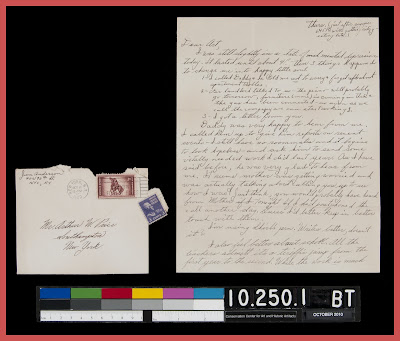The treatments are done!
Ten months ago, I brought in over a dozen representative items from our family collection for conservation treatment at the Conservation Center
First up is one of the courtship letters that my mother wrote to my father when she was going to fashion design school in Manhattan and he was working as a grocery store clerk in Southampton, Long Island . The letter is from October 5, 1949.
As with all the “June and Art” letters, we found them folded in their original envelopes. In preparing the June and Art blog, I removed the letters from the envelopes, unfolded them, and stored them in plastic sleeves kept in a three-ring binder. For the Conservation Center
 |
| Paper conservator Marion Verborg. |
When Marion Verborg, the 2010-2011 N.E.A. Fellow at the Conservation Center Marion
The letter is beautifully flat now. The original creases – 60 years in the making! – are barely visible anymore. This result was achieved through humidification and flattening. After testing the inks to make sure they wouldn’t bleed when exposed to humidity,
Gore-Tex
Pellon*
The Letter
Pellon
Gore-Tex
The Gore-Tex is sprayed with calcium-enriched deionized water on its felt-like face and the absorbed water smoothly humidifies the object (the letter, in this case). After humidification, the object is quickly transferred into a flattening sandwich (Blotter, Pellon, The Letter, Pellon, Blotter) under Plexiglas and weights to restore the planarity (the original flatness of the paper).
Five days later, the result is a VERY flat letter, looking much like it would have when my mother wrote it in her Manhattan apartment 62 years ago.
 |
| Letter and envelope, before treatment (BT). |
* Pellon: Product name for a non-woven polyester web.
© 2011 Lee Price




No comments:
Post a Comment